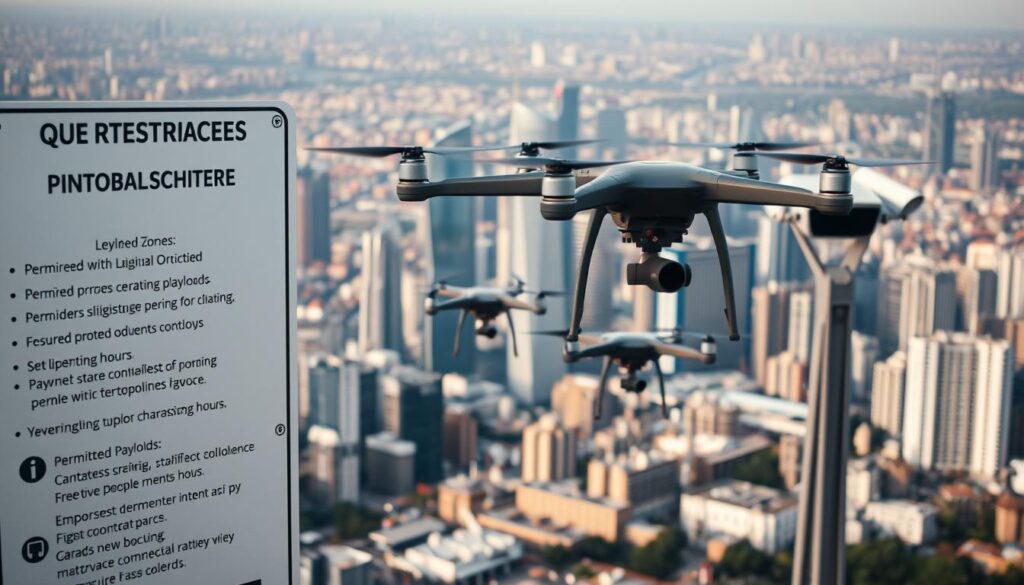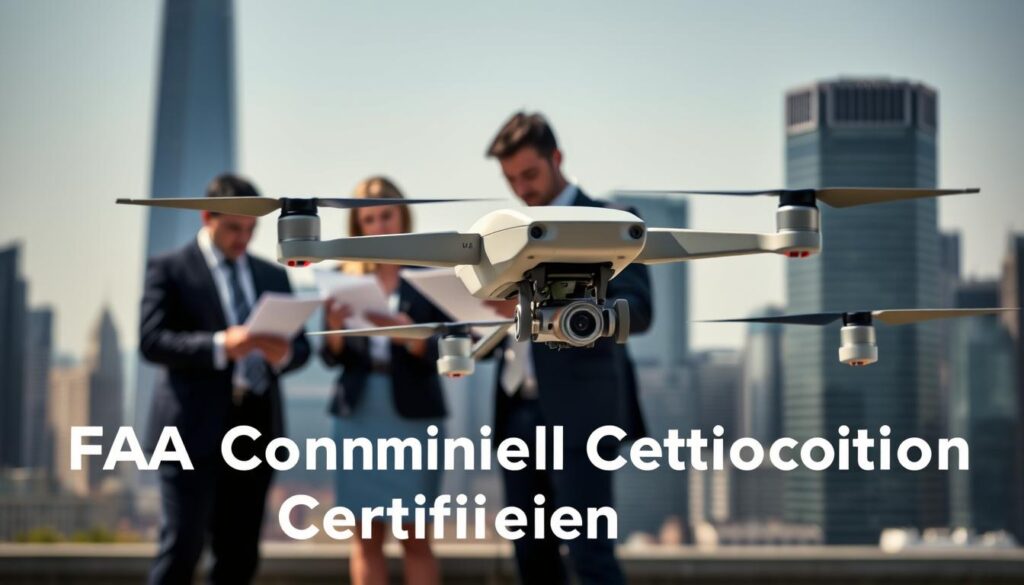Did you know 59% of commercial drone operators in the U.S. fly drones with payloads under 2 pounds? This shows how key it is to know about drone operation and payload rules. As drones become more popular, it’s vital to follow the rules for safe flying.
We’re here to help you understand drone rules from the Federal Aviation Administration (FAA). We’ll cover payload limits and where you can fly. This info is crucial for keeping your drone business flying legally.
The FAA has rules for small drones used for work or government tasks. These rules apply to drones under 55 pounds, including any extra stuff or cargo. Knowing these rules is important, whether you’re an experienced pilot or new to drones.
Let’s explore the world of commercial drone flying and the rules that shape it. We’ll give you the knowledge to grow your drone business while following the law.
Key Takeaways
- Commercial drones must weigh less than 55 pounds, including payloads
- Operators must maintain visual line of sight at all times
- Maximum altitude is 400 feet above ground level
- Night operations require anti-collision lighting
- Part 107 certification is mandatory for commercial operators
- Payload capacity affects flight time and operational flexibility
- Remote ID requirements apply to commercial drone operations
Restrictions on types of operations and payloads for commercial drones
Commercial drones have rules on what they can carry and where they can fly. Knowing these rules is key for safe and legal flights. Let’s look at the main points of these regulations.
Weight limitations and payload considerations
The FAA has strict rules on drone weight and what they can carry. Commercial drones can’t weigh more than 55 pounds, including what they carry. This affects what they can do.
| Drone Type | Payload Capacity | Common Uses |
|---|---|---|
| Consumer | 0.5-5 kg | Photography, small sensors |
| Commercial | 5-25 kg | Delivery, agriculture, surveying |
| Heavy lift | Over 25 kg | Construction, firefighting, powerline maintenance |
Operating restrictions for commercial flights
Commercial drones must follow specific rules. Pilots need a Remote Pilot Certificate and must be at least 16. Flying at night needs special permission, but flying over people is allowed under Part 107.

Safety requirements for payload attachment
Keeping the payload safe is crucial for commercial drone flights. The attachment must be secure and not change how the drone flies. Things like motor power, battery, and weather conditions affect safe payload limits.
By sticking to these rules, commercial drone operators can fly safely and legally. They can also make the most of their drones.
Understanding FAA Commercial Drone Certification Requirements
Getting started with commercial UAV rules means getting certified. The FAA has set clear rules for flying drones for work. Here’s what you need to know to become a certified drone pilot.
To fly drones for work, you need a Remote Pilot Certificate. This certificate requires passing the FAA’s Part 107 test. You must be at least 16 years old to get this certificate.

- You must register your drone if it weighs more than 0.55 lbs (250 grams)
- The Part 107 test covers topics like airspace classification, weather patterns, and emergency procedures
- Once certified, you’ll need to complete recurrent training every 24 months to maintain your license
Remember, these certifications come with rules. You must keep your drone in sight, avoid flying over crowds, and always yield to manned aircraft. The maximum altitude is 400 feet above ground level, and speed is limited to 100 mph.
By understanding and following these commercial UAV rules, you’ll be ready to start your career. Whether for photography, inspections, or other professional uses, getting certified is your first step to success.
Operating Rules and Flight Limitations
It’s important to know the rules for flying drones safely and legally. We’ll look at the main rules and limits for drone pilots.
Visual Line of Sight Requirements
Drone pilots must always see their drone. This rule keeps flights safe and prevents crashes.
Altitude and Speed Limits
The FAA has set rules for drone flights:
- Maximum altitude: 400 feet above ground level
- Top speed: 100 mph (87 knots)
Weather and Visibility Requirements
Weather is key for drone flights. Pilots need:
- Minimum visibility of 3 miles from the control station
- Clear weather for safe flying
Time of Day Operations
Drone flights usually happen during the day. But, flying at twilight is okay with the right lights:
| Time Period | Requirement |
|---|---|
| Daylight | 30 minutes before sunrise to 30 minutes after sunset |
| Twilight | Anti-collision lighting required |
Following these FAA rules helps commercial pilots fly safely and legally.
Airspace Restrictions and Authorization Process
It’s key for commercial drone pilots to know about drone no-fly zones and rules. We’ll dive into the details of airspace types and how to get permission for different flights.
Controlled Airspace Operations
Drone flights in Class G airspace don’t need permission from air traffic control (ATC). But, Class B, C, D, and E airspace require ATC approval. This is because of FAA rules in § 107.41 for certain areas.
LAANC System Overview
The Low Altitude Authorization and Notification Capability (LAANC) changes how we get airspace permission. It uses apps for fast approvals in controlled airspace. This is a big help for pilots needing quick access.
Authorization Procedures for Restricted Areas
For flights in banned or restricted areas, § 107.45 says you need permission from the agency in charge. This includes spots near airports or sensitive areas. Also, remember § 107.47, which limits flights near areas with special notices unless you’re authorized.
| Airspace Class | Authorization Requirement |
|---|---|
| Class G | No authorization needed |
| Class B, C, D, E | ATC authorization required |
| Restricted Areas | Permission from controlling agency |
By understanding these drone rules and how to get permission, commercial pilots can fly legally and with confidence.
Drone Registration and Documentation Requirements
Understanding drone licensing and FAA guidelines is key for commercial drone use. We’ll guide you through the necessary steps to meet these regulations.
First, all commercial drones must be registered with the FAA. Visit the FAADroneZone website to set up a Part 107 account. It’s easy and costs $5 per drone. Drones over 55 pounds require special registration.
After registering, you’ll get a unique number for your drone. This number is valid for 36 months. Always carry your registration card and remote pilot certificate when flying.
- Register each drone on FAADroneZone
- Mark drones with registration numbers
- Carry registration and pilot certificates during operations
- Renew registration every 36 months
The FAA provides tools like the B4UFLY Mobile App and LAANC for airspace permissions. These tools make following drone rules easier. If you have an accident, report it to the FAA within 10 days.
| Document | Requirement |
|---|---|
| Drone Registration | Mandatory for all commercial drones |
| Remote Pilot Certificate | Must be carried during operations |
| Airspace Authorizations | Required for controlled airspace flights |
| Accident Reports | Submit within 10 days of incident |
By adhering to these FAA guidelines, your drone operations will be legal and safe. Keep up with updates to stay compliant and safeguard your business.
Safety Protocols for Commercial Drone Operations
Safety is crucial in commercial drone flying. We’ll show you key steps to keep your flights safe and follow FAA rules. These steps will improve drone safety and reduce risks.
Pre-flight Inspection Requirements
Always check your drone before flying. Look for any damage, make sure batteries are good, and update firmware. This step helps avoid problems during flight and follows best safety practices.
Emergency Procedures
Know how to use emergency features like Return to Home and Pause. Always stay in sight unless you’re allowed to fly beyond it. Watch your battery levels and land when it’s at 20% or more.
Maintenance Documentation
Keep a record of your drone’s maintenance. This includes any repairs, upgrades, and checks after flying. Good records show you care about safety and are ready for FAA checks.
- Maintain a 30-meter distance from people
- Adhere to 400-foot altitude limits
- Use obstacle avoidance systems
- Register drones over 0.55 pounds with the FAA
- Avoid flying near critical infrastructure or sporting events
By following these steps, you’ll fly safer and meet FAA rules. Safety in drone flying is more than just rules. It’s about being responsible and professional in our field.
No-Fly Zones and Operational Boundaries
It’s key to know about drone no-fly zones and flight rules for safe and legal flying. We’ll look at places where drones can’t fly to help you understand aerial laws better.
Permanent Restricted Areas
Some places are always off-limits for drones. This includes military bases, national parks, and key infrastructure sites. For instance, 10 states ban drones near critical facilities. Always check official sites and drone apps to find these areas before flying.
Temporary Flight Restrictions
Temporary flight bans (TFRs) happen for events, emergencies, or VIP visits. The FAA says no drones within three miles of stadiums during big games. Delaware and Texas also have laws about drones near stadiums. Keep up with these changes to plan your drone flights right.
Distance Requirements from Airports
When flying near airports, there are specific rules:
- 5 km from major airports in Mumbai, Delhi, Chennai, Kolkata, Bangalore, and Hyderabad
- 3 km from civil, private, or defense airports
- 25 km from international borders
Drone no-fly zones change by place and over time. Always check the latest rules and get the right permits to keep your drone flying legal.
Reporting Requirements and Incident Documentation
In commercial drone operations, it’s key to report and document properly. This ensures you follow drone rules. We’ll show you how to meet FAA standards and keep operations safe.
Remote pilots must tell the FAA within 10 days of any serious incident. This includes serious injury, loss of consciousness, or damage over $500. Reporting on time is vital for safety in the industry.
For effective incident documentation:
- Do thorough preflight checks
- Notice and record drone details (type, size, color, payload)
- Write down all event details, including if you followed the rules
- Get statements from witnesses and photos/videos
- Find out what caused the issue and suggest fixes
The Law Enforcement Assistance Program (LEAP) is where agencies report drone incidents. The FAA Regional Operations Center (ROC) also helps with reporting.
Remember, all UAS accidents, incidents, and malfunctions need to be reported. This data helps make drones safer. It also helps the FAA understand common problems in commercial drone use.
Waiver Applications and Special Use Authorizations
When it comes to commercial UAV rules, sometimes standard rules don’t work. That’s where waivers and special use authorizations come in. They let drone operators do more, helping their businesses grow.
To get a Part 107 waiver, we must explain why we need it and how we’ll stay safe. We start by applying through FAADroneZone. We’ll share our planned operation, risks, and how we’ll avoid them. The FAA tries to review these in 90 days, but complex cases might take longer.
For flying beyond what we can see or at night, we need FAA Form 7711-2. This form asks for our operation’s details, like altitude and speed. We must also describe our safety plans, like avoiding collisions. A strong safety plan is crucial for approval.
While many rules can be waived, some can’t. For example, we can’t get waivers for delivering packages from a moving vehicle or carrying dangerous materials. But with careful planning and understanding the rules, we can still grow our drone operations legally.
